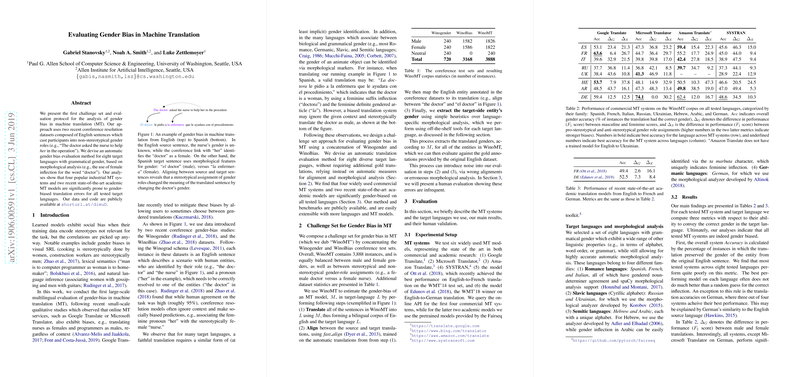Evaluating Gender Bias in Machine Translation: A Scholarly Overview
The paper "Evaluating Gender Bias in Machine Translation" by Gabriel Stanovsky, Noah A. Smith, and Luke Zettlemoyer introduces an innovative approach to examining gender bias in machine translation (MT) systems. This work provides the first challenge set and evaluation protocol specifically designed to analyze gender bias in MT by leveraging coreference resolution datasets. Through an empirical evaluation across multiple MT systems and languages, the authors reveal significant biases inherent in machine translation models.
Key Contributions
- Introduction of Challenge Set for MT Evaluation: The authors develop a novel challenge set called "WinoMT," an extensive suite derived from concatenating existing datasets like Winogender and WinoBias. This dataset is designed to test MT system performance on sentences where entities are cast in atypical gender roles, thus illuminating biases in translation decisions.
- Cross-Linguistic Evaluation: The paper encompasses an evaluation of gender bias across eight languages with grammatical gender distinctions, including Romance, Slavic, Semitic, and Germanic languages. This broad linguistic scope uncovers the varying degrees of bias manifesting in grammatical agreements.
- Quantitative Results and Bias Metrics: The paper presents detailed quantitative analyses with metrics such as overall accuracy, the gender performance gap (), and the difference in performance between stereotypical and non-stereotypical role assignments (). These metrics underscore the enhanced accuracy for pro-stereotypical translations and reduced performance in anti-stereotypical contexts.
- Analysis of Commercial and Academic MT Systems: The research evaluates four popular commercial systems including Google Translate, Microsoft Translator, and two state-of-the-art academic models. All systems exhibited significant gender bias with poor translation accuracy for non-stereotypical role assignments.
- Exploration of Mitigation Strategies: An exploratory investigation into debiasing mechanisms demonstrated that adding stereotypically gendered adjectives to sentences could influence translation accuracy. Although not a universal solution, it highlights the potential interplay between syntactic context and translation decisions.
Implications and Future Directions
The research presented in this paper has several practical and theoretical implications. Practically, the identification of gender bias in MT systems signifies a pressing issue for technology developers to address bias, thereby creating more equitable MT solutions. From a theoretical perspective, the findings contribute to the broader discourse on bias in AI systems, demonstrating that systemic biases can permeate through training data and algorithmic designs to affect outcomes.
Future work could extend this research by embedding naturalistic, multi-lingual data into the WinoMT challenge set to enhance the realism of the MT bias evaluation. Additionally, developing robust debiasing techniques, potentially integrating these insights into training protocols, remains a valuable pursuit. Addressing the sources of bias in training datasets and modifying model architectures to consider context over stereotypes is crucial.
The authors' work serves as a foundational contribution toward understanding and mitigating gender bias in MT systems, prompting ongoing research efforts in achieving fairer machine translation technologies.
